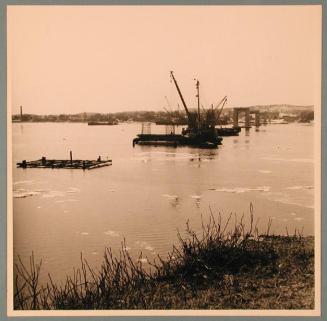Iron Light House, on Minot's Ledge. Off Cohasset, Mass. Bay.
PrinterPrinted by
Elijah Chapman Kellogg
(American, 1811 - 1881)
PublisherPublished by
Elijah Chapman Kellogg
(American, 1811 - 1881)
PublisherPublished by
Ensign, Thayer & Co.
(American, 1850 - 1852)
Date1851
MediumLithography; printer's ink and watercolor on wove paper
DimensionsPrimary Dimensions (image height x width): 11 3/4 x 8 9/16in. (29.8 x 21.7cm)
Sheet (height x width): 14 1/16 x 10in. (35.7 x 25.4cm)
ClassificationsGraphics
Credit LineMuseum purchase
Object number1993.12.0
DescriptionA round iron lighthouse is supported on eight tall iron piers, evidently constructed in segments. Lines or wires crisscross between the piers and apparently lend support. A ladder leads down the left side. Barrels and boxes are stored on a platform below the main structure. Two men stand on a catwalk halfway up the structure. A lifeboat hangs from the bottom of the catwalk. A second catwalk encircles the lighthouse outside the lens. Two windows and a door are visible in the structure. An American flag flies from the roof. A huge wave is breaking at the base of the lighthouse. Three sailing ships and a steamboat are visible on the horizon.
Collections
Status
Not on viewD. W. Kellogg & Co.
1830-1840
D. W. Kellogg & Co.
1830-1840









